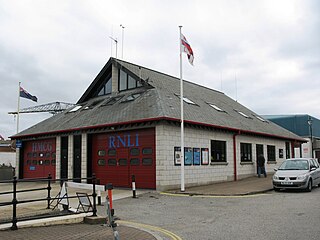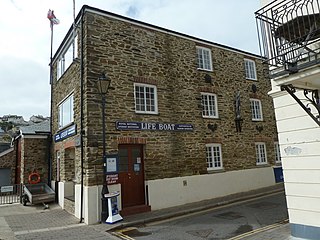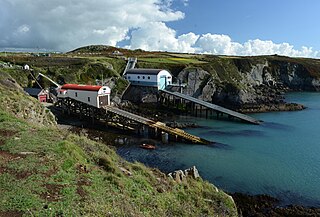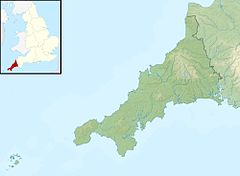
St Mary's is the largest and most populous island of the Isles of Scilly, an archipelago off the southwest coast of Cornwall in England, United Kingdom.

St Mary's Lifeboat Station is situated in St Mary's Harbour, Isles of Scilly and has been an important station for the Royal National Lifeboat Institution since the service began in 1837, however without a service between 1855 and 1874.

Thomas W. Lawson was a seven-masted, steel-hulled schooner built for the Pacific trade, but used primarily to haul coal and oil along the East Coast of the United States. Named for copper baron Thomas W. Lawson, a Boston millionaire, stock-broker, book author, and president of the Boston Bay State Gas Co., she was launched in 1902 as the largest schooner and largest sailing vessel without an auxiliary engine ever built.

St Nicholas's Church, Tresco, is a parish church in the Church of England located in Tresco, Isles of Scilly, UK.

Sheringham Lifeboat Station is an RNLI operated lifeboat station located in the town of Sheringham in the English county of Norfolk. Since 1992, the station has been inshore operations only – currently with an Atlantic 85 rigid inflatable – offshore lifeboats are to the east at Cromer and the west at Wells-next-the-sea.

The Mumbles Lifeboat Station is at Mumbles Pier, located at the south-western corner of Swansea Bay, near the village of Mumbles, within the city and county of Swansea, in the historic county of Glamorgan, Wales.

Falmouth Lifeboat Station is the base for Royal National Lifeboat Institution (RNLI) search and rescue operations at Falmouth, Cornwall in the United Kingdom. The first lifeboat was stationed in the town in 1867 and the present station was opened in 1993. It operates a Severn Class all-weather Lifeboat (ALB) and an Atlantic 85 inshore lifeboat (ILB).

St Ives Lifeboat Station is the base for Royal National Lifeboat Institution (RNLI) search and rescue operations at St Ives, Cornwall in the United Kingdom. The first lifeboat was built for the town in 1840 and the present boathouse was opened in 1994. It operates a Shannon-class All-weather boat (AWB) and a D-class (IB1) inshore lifeboat (ILB).

Penlee Lifeboat Station is the base for Royal National Lifeboat Institution (RNLI) search and rescue operations for Mount's Bay in Cornwall, United Kingdom. The lifeboat station operated at various locations in Penzance from the early 19th century. It moved to Penlee Point near Mousehole in 1913, thus gaining its current name, but was moved to Newlyn in 1983 without any change of name. The station is remembered for the loss of the entire lifeboat crew on 19 December 1981.

Salcombe Lifeboat Station is the base for Royal National Lifeboat Institution (RNLI) search and rescue operations at Salcombe, Devon in England. The first lifeboat was stationed in the town in 1869. The Salcombe Lifeboat has twice capsized, in 1916 with the loss of 13 lives, and in 1983 with no loss of life. Since 2008 the station has operated a Tamar-class all weather boat (ALB) and an Atlantic 85 inshore lifeboat (ILB).

Sennen Cove Lifeboat Station is the base for Royal National Lifeboat Institution (RNLI) search and rescue operations for the sea around Land's End, Cornwall in the United Kingdom. The first lifeboat was stationed at Sennen Cove in 1853. Since 2009 it has operated a Tamar-class all-weather boat (ALB) and a D-class (IB1) inshore lifeboat (ILB).

Fishguard Lifeboat Station in located on the quay, at the northern breakwater of Fishguard Harbour, in the community of Fishguard and Goodwick, in the county of Pembrokeshire, Wales.

St Davids Lifeboat Station is a Royal National Lifeboat Institution (RNLI) station. It was opened in 1869 and to date has been involved in saving over 360 lives at sea in more than 420 launches. The station operates both an all-weather (ALB) and an inshore (ILB) lifeboat.

The Watson-class lifeboat is a design of wooden lifeboat operated by the Royal National Lifeboat Institution (RNLI) around the coasts of the United Kingdom and Ireland between 1888 and 1991. There were several variations over the years but all the boats had hulls that conformed to a design by George Lennox Watson, the RNLI's naval architect from 1887 until his death in 1904.

St Agnes Lifeboat Station was opened in 1968 and is based in St Agnes, Cornwall, South West England. It is operated by the Royal National Lifeboat Institution (RNLI). Until 2015 the station's lifeboats were sponsored by BBC TV's Blue Peter programme and named Blue Peter IV.

Clovelly Lifeboat Station, serving the North Devon village of Clovelly and surrounding coastal waters, is run by the Royal National Lifeboat Institution (RNLI). It was established in 1870. The station is flanked by Appledore to the northeast and Bude to the southwest.



















